Improving Employee Motivation and Leadership at Caterpillar Inc.
VerifiedAdded on 2019/11/14
|8
|2087
|182
Report
AI Summary
This report examines the employee motivation issues at Caterpillar Inc., a leading manufacturer facing significant employee dissatisfaction despite high profits. The report identifies problems at individual, group, and organizational levels, attributing them to poor leadership, particularly the CEO's attitude and lack of empathy, as well as unfavorable market conditions. The analysis delves into person and environmental factors, referencing relevant concepts like servant leadership and ERG theory. Recommendations include leadership development, rewarding both individual and team performance to improve employee morale and make Caterpillar an 'Employer of Choice'. The report concludes that addressing leadership deficiencies and implementing reward systems are crucial for enhancing employee satisfaction and overall organizational success.
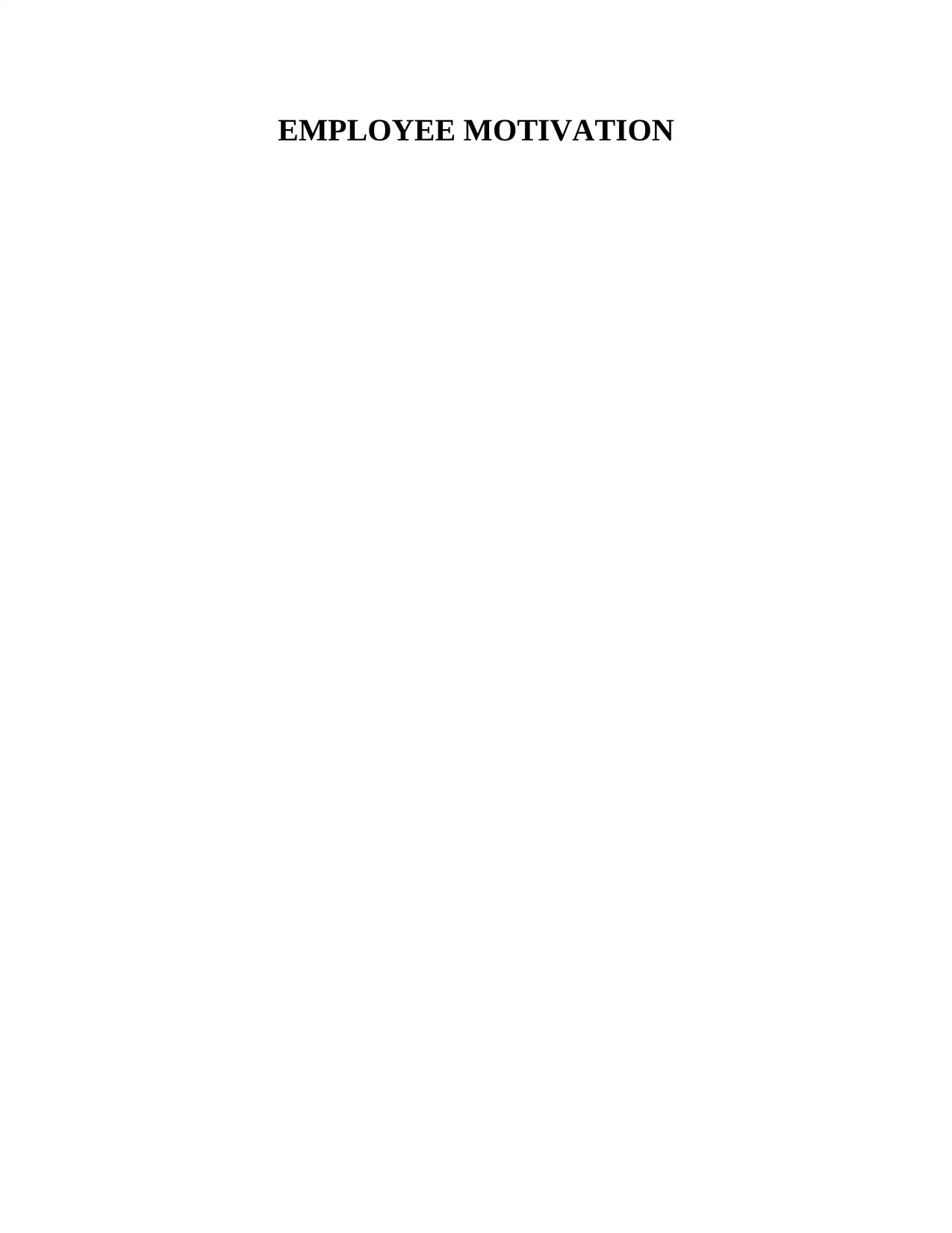
EMPLOYEE MOTIVATION
Paraphrase This Document
Need a fresh take? Get an instant paraphrase of this document with our AI Paraphraser
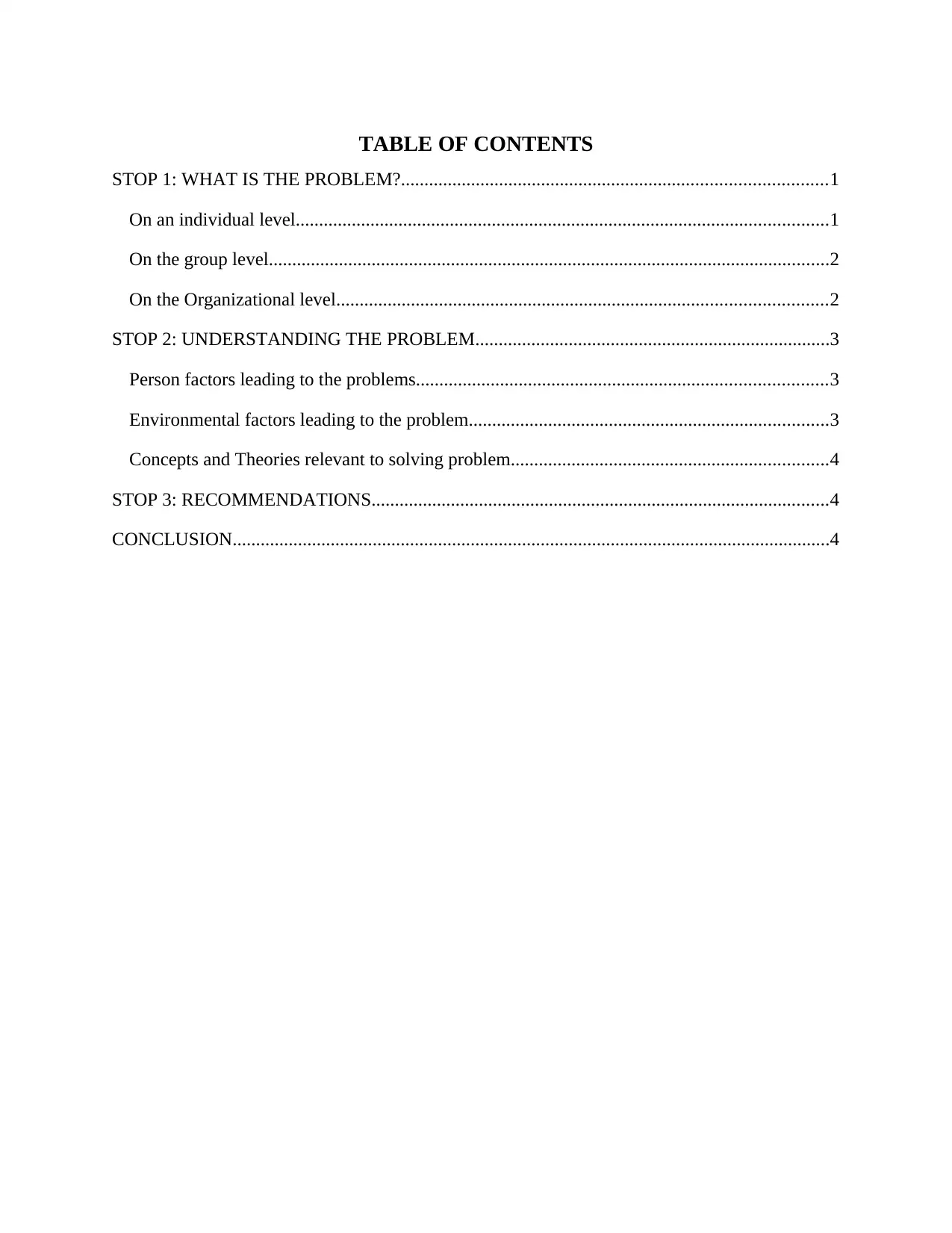
TABLE OF CONTENTS
STOP 1: WHAT IS THE PROBLEM?...........................................................................................1
On an individual level..................................................................................................................1
On the group level........................................................................................................................2
On the Organizational level.........................................................................................................2
STOP 2: UNDERSTANDING THE PROBLEM............................................................................3
Person factors leading to the problems........................................................................................3
Environmental factors leading to the problem.............................................................................3
Concepts and Theories relevant to solving problem....................................................................4
STOP 3: RECOMMENDATIONS..................................................................................................4
CONCLUSION................................................................................................................................4
STOP 1: WHAT IS THE PROBLEM?...........................................................................................1
On an individual level..................................................................................................................1
On the group level........................................................................................................................2
On the Organizational level.........................................................................................................2
STOP 2: UNDERSTANDING THE PROBLEM............................................................................3
Person factors leading to the problems........................................................................................3
Environmental factors leading to the problem.............................................................................3
Concepts and Theories relevant to solving problem....................................................................4
STOP 3: RECOMMENDATIONS..................................................................................................4
CONCLUSION................................................................................................................................4
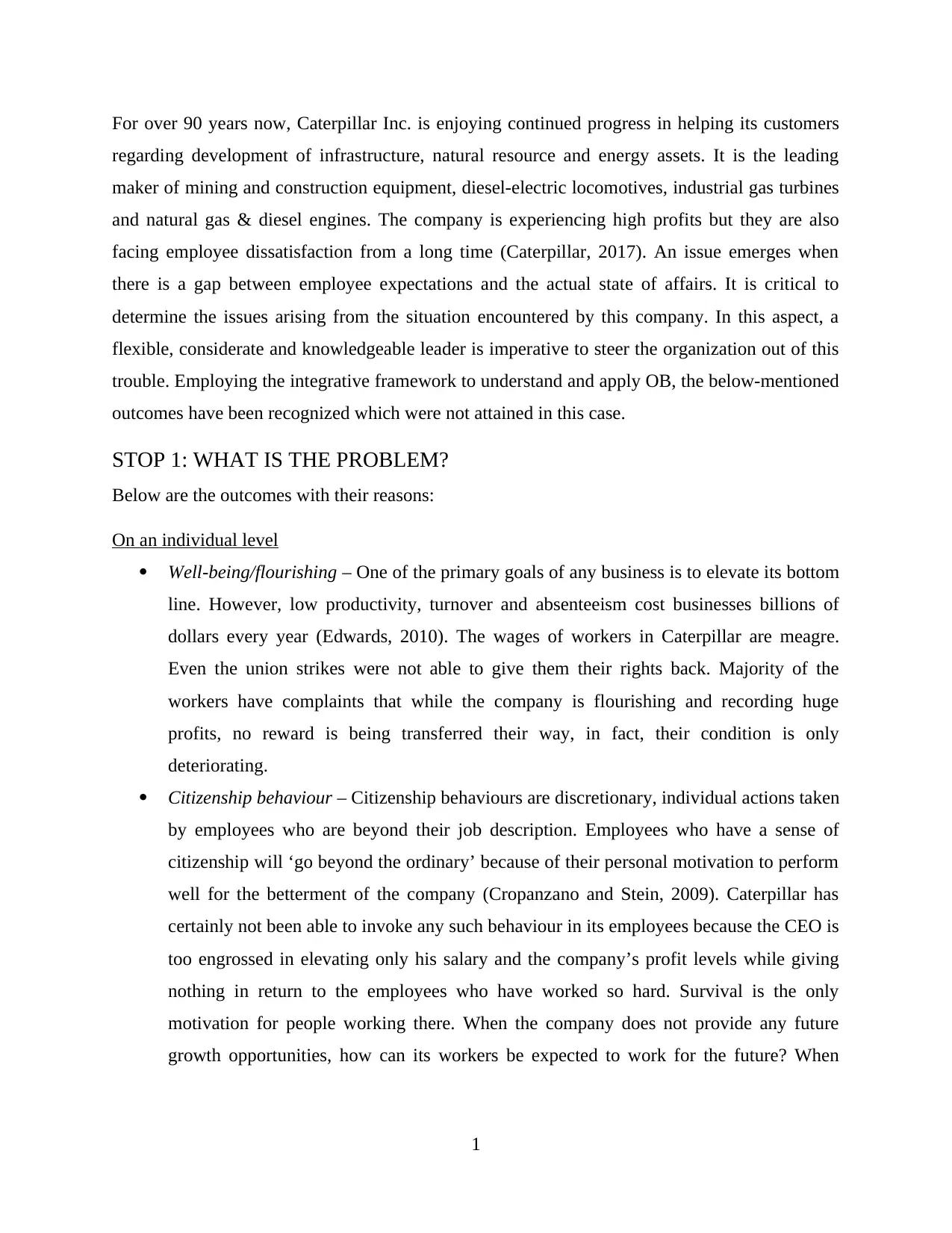
For over 90 years now, Caterpillar Inc. is enjoying continued progress in helping its customers
regarding development of infrastructure, natural resource and energy assets. It is the leading
maker of mining and construction equipment, diesel-electric locomotives, industrial gas turbines
and natural gas & diesel engines. The company is experiencing high profits but they are also
facing employee dissatisfaction from a long time (Caterpillar, 2017). An issue emerges when
there is a gap between employee expectations and the actual state of affairs. It is critical to
determine the issues arising from the situation encountered by this company. In this aspect, a
flexible, considerate and knowledgeable leader is imperative to steer the organization out of this
trouble. Employing the integrative framework to understand and apply OB, the below-mentioned
outcomes have been recognized which were not attained in this case.
STOP 1: WHAT IS THE PROBLEM?
Below are the outcomes with their reasons:
On an individual level
Well-being/flourishing – One of the primary goals of any business is to elevate its bottom
line. However, low productivity, turnover and absenteeism cost businesses billions of
dollars every year (Edwards, 2010). The wages of workers in Caterpillar are meagre.
Even the union strikes were not able to give them their rights back. Majority of the
workers have complaints that while the company is flourishing and recording huge
profits, no reward is being transferred their way, in fact, their condition is only
deteriorating.
Citizenship behaviour – Citizenship behaviours are discretionary, individual actions taken
by employees who are beyond their job description. Employees who have a sense of
citizenship will ‘go beyond the ordinary’ because of their personal motivation to perform
well for the betterment of the company (Cropanzano and Stein, 2009). Caterpillar has
certainly not been able to invoke any such behaviour in its employees because the CEO is
too engrossed in elevating only his salary and the company’s profit levels while giving
nothing in return to the employees who have worked so hard. Survival is the only
motivation for people working there. When the company does not provide any future
growth opportunities, how can its workers be expected to work for the future? When
1
regarding development of infrastructure, natural resource and energy assets. It is the leading
maker of mining and construction equipment, diesel-electric locomotives, industrial gas turbines
and natural gas & diesel engines. The company is experiencing high profits but they are also
facing employee dissatisfaction from a long time (Caterpillar, 2017). An issue emerges when
there is a gap between employee expectations and the actual state of affairs. It is critical to
determine the issues arising from the situation encountered by this company. In this aspect, a
flexible, considerate and knowledgeable leader is imperative to steer the organization out of this
trouble. Employing the integrative framework to understand and apply OB, the below-mentioned
outcomes have been recognized which were not attained in this case.
STOP 1: WHAT IS THE PROBLEM?
Below are the outcomes with their reasons:
On an individual level
Well-being/flourishing – One of the primary goals of any business is to elevate its bottom
line. However, low productivity, turnover and absenteeism cost businesses billions of
dollars every year (Edwards, 2010). The wages of workers in Caterpillar are meagre.
Even the union strikes were not able to give them their rights back. Majority of the
workers have complaints that while the company is flourishing and recording huge
profits, no reward is being transferred their way, in fact, their condition is only
deteriorating.
Citizenship behaviour – Citizenship behaviours are discretionary, individual actions taken
by employees who are beyond their job description. Employees who have a sense of
citizenship will ‘go beyond the ordinary’ because of their personal motivation to perform
well for the betterment of the company (Cropanzano and Stein, 2009). Caterpillar has
certainly not been able to invoke any such behaviour in its employees because the CEO is
too engrossed in elevating only his salary and the company’s profit levels while giving
nothing in return to the employees who have worked so hard. Survival is the only
motivation for people working there. When the company does not provide any future
growth opportunities, how can its workers be expected to work for the future? When
1
⊘ This is a preview!⊘
Do you want full access?
Subscribe today to unlock all pages.

Trusted by 1+ million students worldwide
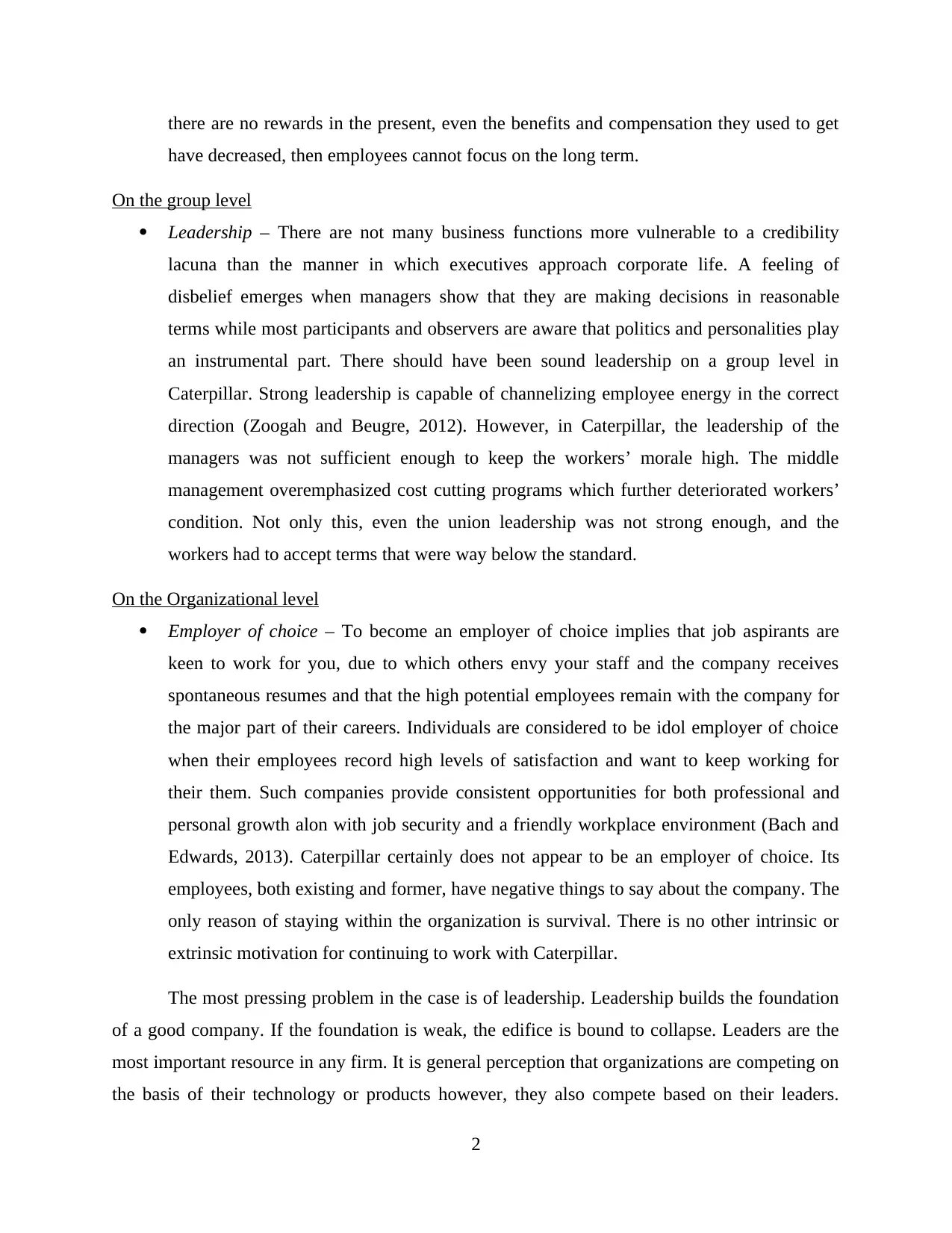
there are no rewards in the present, even the benefits and compensation they used to get
have decreased, then employees cannot focus on the long term.
On the group level
Leadership – There are not many business functions more vulnerable to a credibility
lacuna than the manner in which executives approach corporate life. A feeling of
disbelief emerges when managers show that they are making decisions in reasonable
terms while most participants and observers are aware that politics and personalities play
an instrumental part. There should have been sound leadership on a group level in
Caterpillar. Strong leadership is capable of channelizing employee energy in the correct
direction (Zoogah and Beugre, 2012). However, in Caterpillar, the leadership of the
managers was not sufficient enough to keep the workers’ morale high. The middle
management overemphasized cost cutting programs which further deteriorated workers’
condition. Not only this, even the union leadership was not strong enough, and the
workers had to accept terms that were way below the standard.
On the Organizational level
Employer of choice – To become an employer of choice implies that job aspirants are
keen to work for you, due to which others envy your staff and the company receives
spontaneous resumes and that the high potential employees remain with the company for
the major part of their careers. Individuals are considered to be idol employer of choice
when their employees record high levels of satisfaction and want to keep working for
their them. Such companies provide consistent opportunities for both professional and
personal growth alon with job security and a friendly workplace environment (Bach and
Edwards, 2013). Caterpillar certainly does not appear to be an employer of choice. Its
employees, both existing and former, have negative things to say about the company. The
only reason of staying within the organization is survival. There is no other intrinsic or
extrinsic motivation for continuing to work with Caterpillar.
The most pressing problem in the case is of leadership. Leadership builds the foundation
of a good company. If the foundation is weak, the edifice is bound to collapse. Leaders are the
most important resource in any firm. It is general perception that organizations are competing on
the basis of their technology or products however, they also compete based on their leaders.
2
have decreased, then employees cannot focus on the long term.
On the group level
Leadership – There are not many business functions more vulnerable to a credibility
lacuna than the manner in which executives approach corporate life. A feeling of
disbelief emerges when managers show that they are making decisions in reasonable
terms while most participants and observers are aware that politics and personalities play
an instrumental part. There should have been sound leadership on a group level in
Caterpillar. Strong leadership is capable of channelizing employee energy in the correct
direction (Zoogah and Beugre, 2012). However, in Caterpillar, the leadership of the
managers was not sufficient enough to keep the workers’ morale high. The middle
management overemphasized cost cutting programs which further deteriorated workers’
condition. Not only this, even the union leadership was not strong enough, and the
workers had to accept terms that were way below the standard.
On the Organizational level
Employer of choice – To become an employer of choice implies that job aspirants are
keen to work for you, due to which others envy your staff and the company receives
spontaneous resumes and that the high potential employees remain with the company for
the major part of their careers. Individuals are considered to be idol employer of choice
when their employees record high levels of satisfaction and want to keep working for
their them. Such companies provide consistent opportunities for both professional and
personal growth alon with job security and a friendly workplace environment (Bach and
Edwards, 2013). Caterpillar certainly does not appear to be an employer of choice. Its
employees, both existing and former, have negative things to say about the company. The
only reason of staying within the organization is survival. There is no other intrinsic or
extrinsic motivation for continuing to work with Caterpillar.
The most pressing problem in the case is of leadership. Leadership builds the foundation
of a good company. If the foundation is weak, the edifice is bound to collapse. Leaders are the
most important resource in any firm. It is general perception that organizations are competing on
the basis of their technology or products however, they also compete based on their leaders.
2
Paraphrase This Document
Need a fresh take? Get an instant paraphrase of this document with our AI Paraphraser
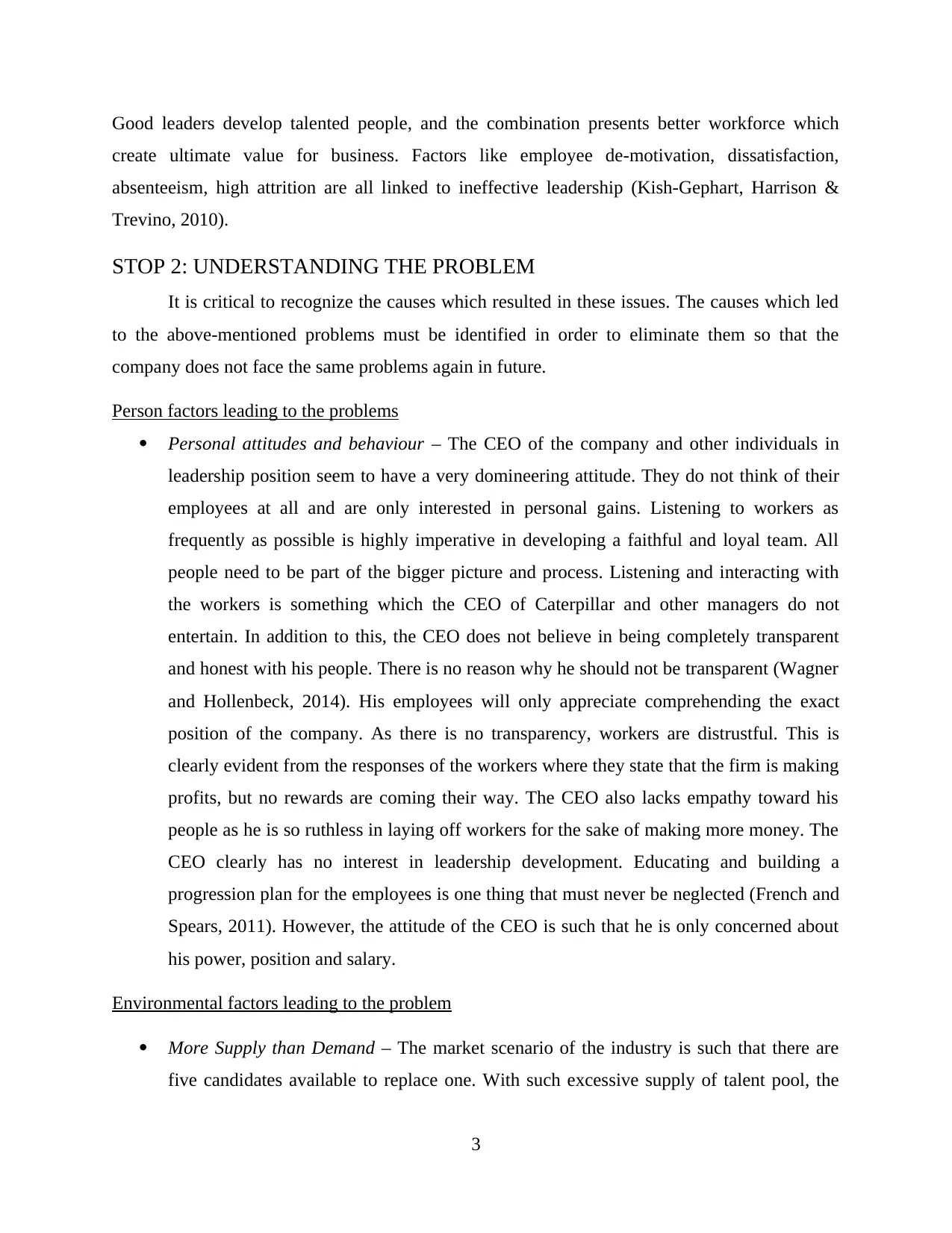
Good leaders develop talented people, and the combination presents better workforce which
create ultimate value for business. Factors like employee de-motivation, dissatisfaction,
absenteeism, high attrition are all linked to ineffective leadership (Kish-Gephart, Harrison &
Trevino, 2010).
STOP 2: UNDERSTANDING THE PROBLEM
It is critical to recognize the causes which resulted in these issues. The causes which led
to the above-mentioned problems must be identified in order to eliminate them so that the
company does not face the same problems again in future.
Person factors leading to the problems
Personal attitudes and behaviour – The CEO of the company and other individuals in
leadership position seem to have a very domineering attitude. They do not think of their
employees at all and are only interested in personal gains. Listening to workers as
frequently as possible is highly imperative in developing a faithful and loyal team. All
people need to be part of the bigger picture and process. Listening and interacting with
the workers is something which the CEO of Caterpillar and other managers do not
entertain. In addition to this, the CEO does not believe in being completely transparent
and honest with his people. There is no reason why he should not be transparent (Wagner
and Hollenbeck, 2014). His employees will only appreciate comprehending the exact
position of the company. As there is no transparency, workers are distrustful. This is
clearly evident from the responses of the workers where they state that the firm is making
profits, but no rewards are coming their way. The CEO also lacks empathy toward his
people as he is so ruthless in laying off workers for the sake of making more money. The
CEO clearly has no interest in leadership development. Educating and building a
progression plan for the employees is one thing that must never be neglected (French and
Spears, 2011). However, the attitude of the CEO is such that he is only concerned about
his power, position and salary.
Environmental factors leading to the problem
More Supply than Demand – The market scenario of the industry is such that there are
five candidates available to replace one. With such excessive supply of talent pool, the
3
create ultimate value for business. Factors like employee de-motivation, dissatisfaction,
absenteeism, high attrition are all linked to ineffective leadership (Kish-Gephart, Harrison &
Trevino, 2010).
STOP 2: UNDERSTANDING THE PROBLEM
It is critical to recognize the causes which resulted in these issues. The causes which led
to the above-mentioned problems must be identified in order to eliminate them so that the
company does not face the same problems again in future.
Person factors leading to the problems
Personal attitudes and behaviour – The CEO of the company and other individuals in
leadership position seem to have a very domineering attitude. They do not think of their
employees at all and are only interested in personal gains. Listening to workers as
frequently as possible is highly imperative in developing a faithful and loyal team. All
people need to be part of the bigger picture and process. Listening and interacting with
the workers is something which the CEO of Caterpillar and other managers do not
entertain. In addition to this, the CEO does not believe in being completely transparent
and honest with his people. There is no reason why he should not be transparent (Wagner
and Hollenbeck, 2014). His employees will only appreciate comprehending the exact
position of the company. As there is no transparency, workers are distrustful. This is
clearly evident from the responses of the workers where they state that the firm is making
profits, but no rewards are coming their way. The CEO also lacks empathy toward his
people as he is so ruthless in laying off workers for the sake of making more money. The
CEO clearly has no interest in leadership development. Educating and building a
progression plan for the employees is one thing that must never be neglected (French and
Spears, 2011). However, the attitude of the CEO is such that he is only concerned about
his power, position and salary.
Environmental factors leading to the problem
More Supply than Demand – The market scenario of the industry is such that there are
five candidates available to replace one. With such excessive supply of talent pool, the
3
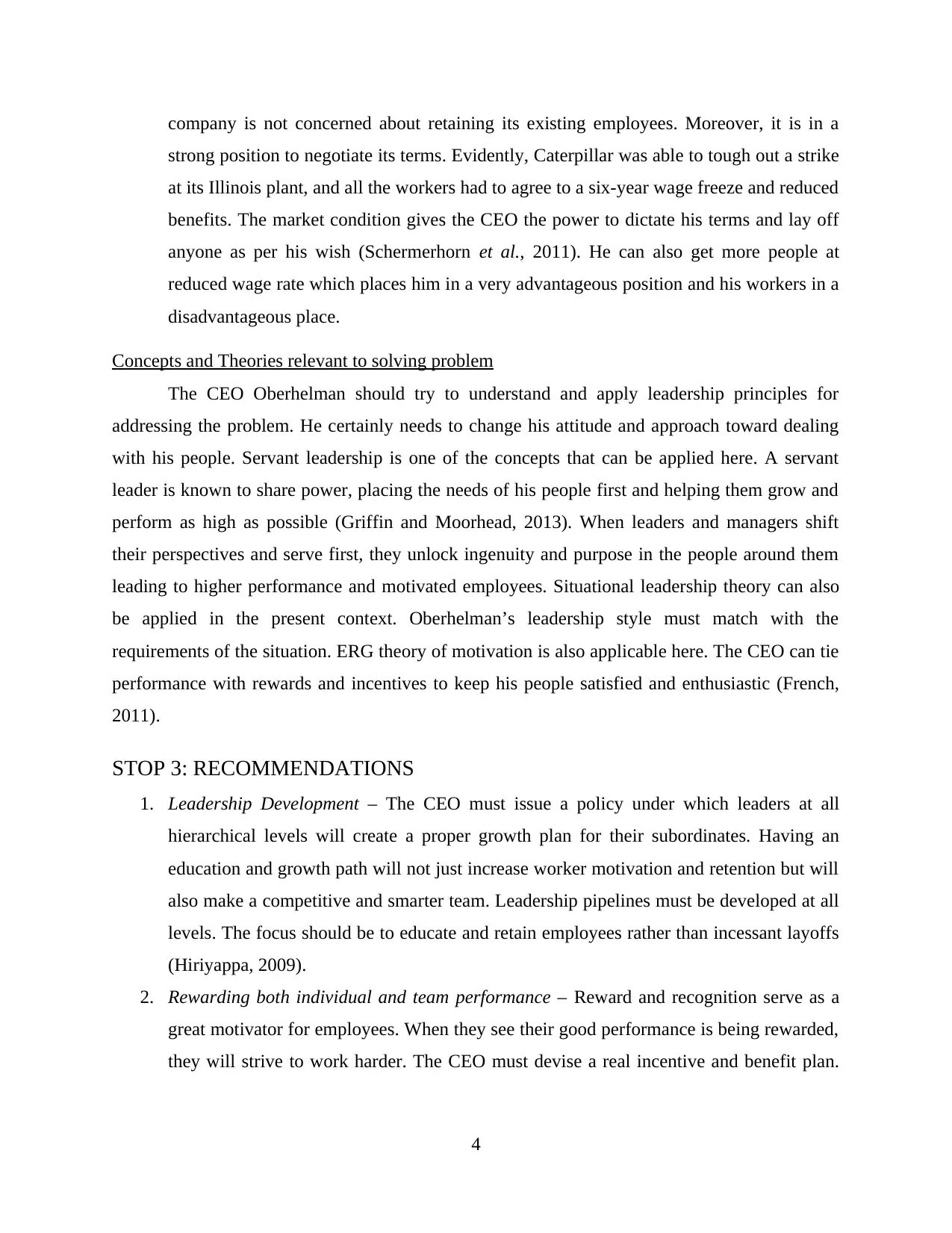
company is not concerned about retaining its existing employees. Moreover, it is in a
strong position to negotiate its terms. Evidently, Caterpillar was able to tough out a strike
at its Illinois plant, and all the workers had to agree to a six-year wage freeze and reduced
benefits. The market condition gives the CEO the power to dictate his terms and lay off
anyone as per his wish (Schermerhorn et al., 2011). He can also get more people at
reduced wage rate which places him in a very advantageous position and his workers in a
disadvantageous place.
Concepts and Theories relevant to solving problem
The CEO Oberhelman should try to understand and apply leadership principles for
addressing the problem. He certainly needs to change his attitude and approach toward dealing
with his people. Servant leadership is one of the concepts that can be applied here. A servant
leader is known to share power, placing the needs of his people first and helping them grow and
perform as high as possible (Griffin and Moorhead, 2013). When leaders and managers shift
their perspectives and serve first, they unlock ingenuity and purpose in the people around them
leading to higher performance and motivated employees. Situational leadership theory can also
be applied in the present context. Oberhelman’s leadership style must match with the
requirements of the situation. ERG theory of motivation is also applicable here. The CEO can tie
performance with rewards and incentives to keep his people satisfied and enthusiastic (French,
2011).
STOP 3: RECOMMENDATIONS
1. Leadership Development – The CEO must issue a policy under which leaders at all
hierarchical levels will create a proper growth plan for their subordinates. Having an
education and growth path will not just increase worker motivation and retention but will
also make a competitive and smarter team. Leadership pipelines must be developed at all
levels. The focus should be to educate and retain employees rather than incessant layoffs
(Hiriyappa, 2009).
2. Rewarding both individual and team performance – Reward and recognition serve as a
great motivator for employees. When they see their good performance is being rewarded,
they will strive to work harder. The CEO must devise a real incentive and benefit plan.
4
strong position to negotiate its terms. Evidently, Caterpillar was able to tough out a strike
at its Illinois plant, and all the workers had to agree to a six-year wage freeze and reduced
benefits. The market condition gives the CEO the power to dictate his terms and lay off
anyone as per his wish (Schermerhorn et al., 2011). He can also get more people at
reduced wage rate which places him in a very advantageous position and his workers in a
disadvantageous place.
Concepts and Theories relevant to solving problem
The CEO Oberhelman should try to understand and apply leadership principles for
addressing the problem. He certainly needs to change his attitude and approach toward dealing
with his people. Servant leadership is one of the concepts that can be applied here. A servant
leader is known to share power, placing the needs of his people first and helping them grow and
perform as high as possible (Griffin and Moorhead, 2013). When leaders and managers shift
their perspectives and serve first, they unlock ingenuity and purpose in the people around them
leading to higher performance and motivated employees. Situational leadership theory can also
be applied in the present context. Oberhelman’s leadership style must match with the
requirements of the situation. ERG theory of motivation is also applicable here. The CEO can tie
performance with rewards and incentives to keep his people satisfied and enthusiastic (French,
2011).
STOP 3: RECOMMENDATIONS
1. Leadership Development – The CEO must issue a policy under which leaders at all
hierarchical levels will create a proper growth plan for their subordinates. Having an
education and growth path will not just increase worker motivation and retention but will
also make a competitive and smarter team. Leadership pipelines must be developed at all
levels. The focus should be to educate and retain employees rather than incessant layoffs
(Hiriyappa, 2009).
2. Rewarding both individual and team performance – Reward and recognition serve as a
great motivator for employees. When they see their good performance is being rewarded,
they will strive to work harder. The CEO must devise a real incentive and benefit plan.
4
⊘ This is a preview!⊘
Do you want full access?
Subscribe today to unlock all pages.

Trusted by 1+ million students worldwide
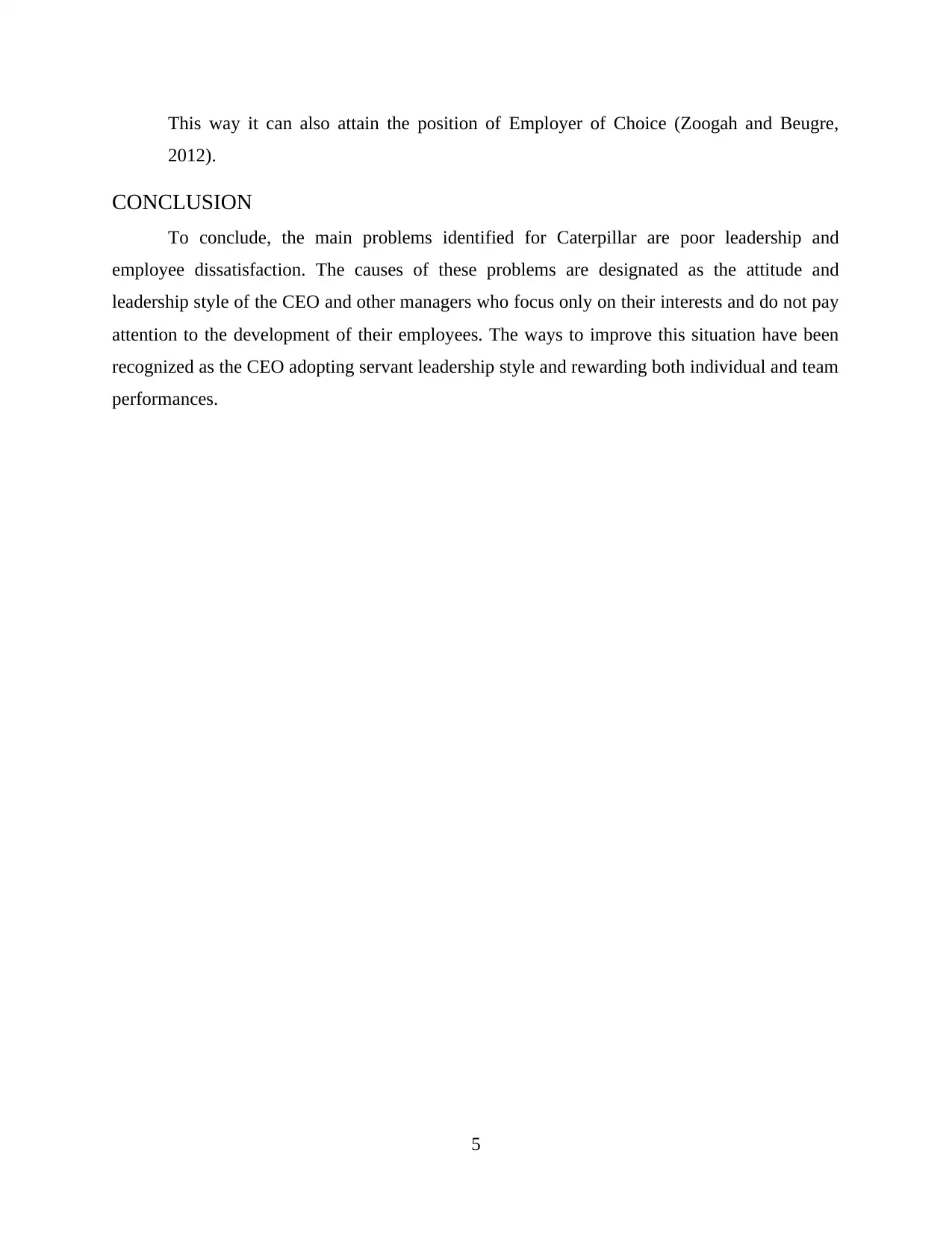
This way it can also attain the position of Employer of Choice (Zoogah and Beugre,
2012).
CONCLUSION
To conclude, the main problems identified for Caterpillar are poor leadership and
employee dissatisfaction. The causes of these problems are designated as the attitude and
leadership style of the CEO and other managers who focus only on their interests and do not pay
attention to the development of their employees. The ways to improve this situation have been
recognized as the CEO adopting servant leadership style and rewarding both individual and team
performances.
5
2012).
CONCLUSION
To conclude, the main problems identified for Caterpillar are poor leadership and
employee dissatisfaction. The causes of these problems are designated as the attitude and
leadership style of the CEO and other managers who focus only on their interests and do not pay
attention to the development of their employees. The ways to improve this situation have been
recognized as the CEO adopting servant leadership style and rewarding both individual and team
performances.
5
Paraphrase This Document
Need a fresh take? Get an instant paraphrase of this document with our AI Paraphraser
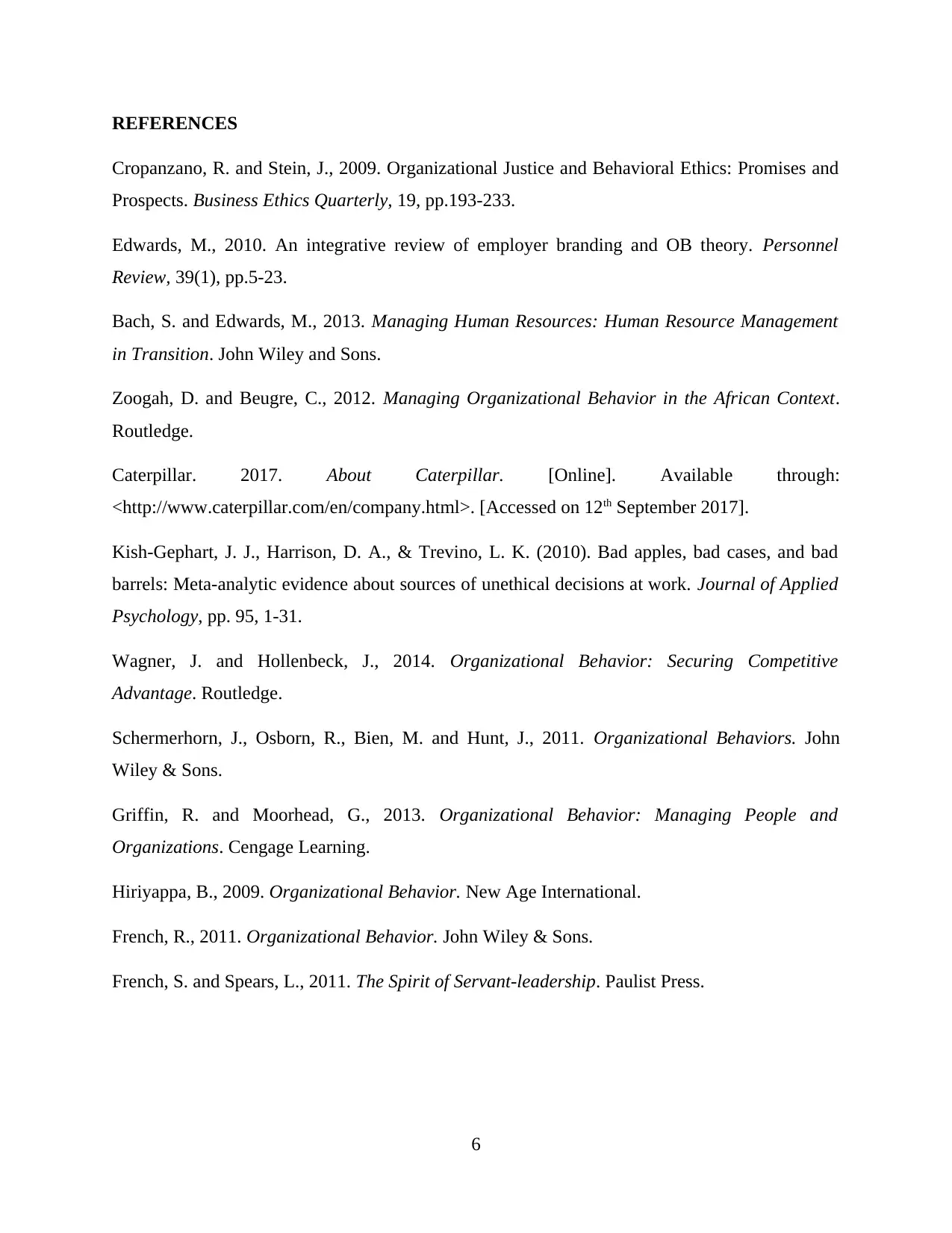
REFERENCES
Cropanzano, R. and Stein, J., 2009. Organizational Justice and Behavioral Ethics: Promises and
Prospects. Business Ethics Quarterly, 19, pp.193-233.
Edwards, M., 2010. An integrative review of employer branding and OB theory. Personnel
Review, 39(1), pp.5-23.
Bach, S. and Edwards, M., 2013. Managing Human Resources: Human Resource Management
in Transition. John Wiley and Sons.
Zoogah, D. and Beugre, C., 2012. Managing Organizational Behavior in the African Context.
Routledge.
Caterpillar. 2017. About Caterpillar. [Online]. Available through:
<http://www.caterpillar.com/en/company.html>. [Accessed on 12th September 2017].
Kish-Gephart, J. J., Harrison, D. A., & Trevino, L. K. (2010). Bad apples, bad cases, and bad
barrels: Meta-analytic evidence about sources of unethical decisions at work. Journal of Applied
Psychology, pp. 95, 1-31.
Wagner, J. and Hollenbeck, J., 2014. Organizational Behavior: Securing Competitive
Advantage. Routledge.
Schermerhorn, J., Osborn, R., Bien, M. and Hunt, J., 2011. Organizational Behaviors. John
Wiley & Sons.
Griffin, R. and Moorhead, G., 2013. Organizational Behavior: Managing People and
Organizations. Cengage Learning.
Hiriyappa, B., 2009. Organizational Behavior. New Age International.
French, R., 2011. Organizational Behavior. John Wiley & Sons.
French, S. and Spears, L., 2011. The Spirit of Servant-leadership. Paulist Press.
6
Cropanzano, R. and Stein, J., 2009. Organizational Justice and Behavioral Ethics: Promises and
Prospects. Business Ethics Quarterly, 19, pp.193-233.
Edwards, M., 2010. An integrative review of employer branding and OB theory. Personnel
Review, 39(1), pp.5-23.
Bach, S. and Edwards, M., 2013. Managing Human Resources: Human Resource Management
in Transition. John Wiley and Sons.
Zoogah, D. and Beugre, C., 2012. Managing Organizational Behavior in the African Context.
Routledge.
Caterpillar. 2017. About Caterpillar. [Online]. Available through:
<http://www.caterpillar.com/en/company.html>. [Accessed on 12th September 2017].
Kish-Gephart, J. J., Harrison, D. A., & Trevino, L. K. (2010). Bad apples, bad cases, and bad
barrels: Meta-analytic evidence about sources of unethical decisions at work. Journal of Applied
Psychology, pp. 95, 1-31.
Wagner, J. and Hollenbeck, J., 2014. Organizational Behavior: Securing Competitive
Advantage. Routledge.
Schermerhorn, J., Osborn, R., Bien, M. and Hunt, J., 2011. Organizational Behaviors. John
Wiley & Sons.
Griffin, R. and Moorhead, G., 2013. Organizational Behavior: Managing People and
Organizations. Cengage Learning.
Hiriyappa, B., 2009. Organizational Behavior. New Age International.
French, R., 2011. Organizational Behavior. John Wiley & Sons.
French, S. and Spears, L., 2011. The Spirit of Servant-leadership. Paulist Press.
6
1 out of 8
Related Documents
Your All-in-One AI-Powered Toolkit for Academic Success.
+13062052269
info@desklib.com
Available 24*7 on WhatsApp / Email
![[object Object]](/_next/static/media/star-bottom.7253800d.svg)
Unlock your academic potential
Copyright © 2020–2025 A2Z Services. All Rights Reserved. Developed and managed by ZUCOL.





